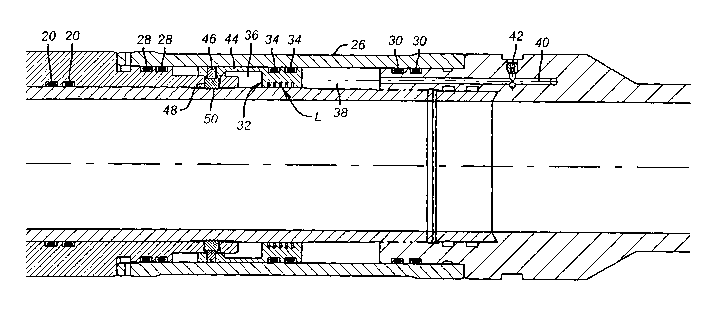Some of the information on this Web page has been provided by external sources. The Government of Canada is not responsible for the accuracy, reliability or currency of the information supplied by external sources. Users wishing to rely upon this information should consult directly with the source of the information. Content provided by external sources is not subject to official languages, privacy and accessibility requirements.
Any discrepancies in the text and image of the Claims and Abstract are due to differing posting times. Text of the Claims and Abstract are posted:
| (12) Patent Application: | (11) CA 2454948 |
|---|---|
| (54) English Title: | LABYRINTH LOCK SEAL FOR HYDROSTATICALLY SET PACKER |
| (54) French Title: | JOINT DE VERROUILLAGE DE LABYRINTHE POUR GARNITURE DEFINIE HYDROSTATIQUEMENT |
| Status: | Deemed Abandoned and Beyond the Period of Reinstatement - Pending Response to Notice of Disregarded Communication |
| (51) International Patent Classification (IPC): |
|
|---|---|
| (72) Inventors : |
|
| (73) Owners : |
|
| (71) Applicants : |
|
| (74) Agent: | MARKS & CLERK |
| (74) Associate agent: | |
| (45) Issued: | |
| (86) PCT Filing Date: | 2002-07-19 |
| (87) Open to Public Inspection: | 2003-02-13 |
| Examination requested: | 2004-01-23 |
| Availability of licence: | N/A |
| Dedicated to the Public: | N/A |
| (25) Language of filing: | English |
| Patent Cooperation Treaty (PCT): | Yes |
|---|---|
| (86) PCT Filing Number: | PCT/US2002/022993 |
| (87) International Publication Number: | WO 2003012252 |
| (85) National Entry: | 2004-01-23 |
| (30) Application Priority Data: | ||||||
|---|---|---|---|---|---|---|
|
A hydrostatically set packer is disclosed. The actuating piston (18) is locked
for run in by a lock sleeve (32) and lock dog (48) arrangement. When the
desired depth is reached well pressure is built up to break a rupture disc
(42) to allow hydrostatic pressure to act on one side of a lock sleeve. The
other side of the lock sleeve is exposed to a chamber (36) under atmospheric
or low pressure. Movement of the lock sleeve releases the lock dog allowing
piston movement to set the packer. The lock sleeve has a labyrinth seal (L) so
that seal leakage below a predetermined level will not prematurely activate
the piston lock and prematurely set the packer. A variety of designs for the
labyrinth are described-
L'invention concerne une garniture définie hydrostatiquement. Le piston de commande (18) est bloqué par un manchon de blocage (32) et un agencement taquet de blocage (48). Lorsque la profondeur souhaitée est atteinte, la pression du puits rompt un disque de rupture (42) afin de permettre à la pression hydrostatique d'agir sur un côté du manchon de blocage. L'autre côté du manchon de blocage est exposé à une chambre (36) sous pression atmosphérique ou sous faible pression. Le mouvement du manchon de blocage libère le taquet de blocage permettant au piston de se déplacer pour fixer la garniture. Le manchon de blocage présente un joint labyrinthe L de manière qu'une fuite inférieure à un niveau prédéterminé ne va pas actionner de manière prématurée le blocage du piston ni fixer prématurément la garniture. Une grande variété de motifs font également l'objet de cette invention.
Note: Claims are shown in the official language in which they were submitted.
Note: Descriptions are shown in the official language in which they were submitted.

2024-08-01:As part of the Next Generation Patents (NGP) transition, the Canadian Patents Database (CPD) now contains a more detailed Event History, which replicates the Event Log of our new back-office solution.
Please note that "Inactive:" events refers to events no longer in use in our new back-office solution.
For a clearer understanding of the status of the application/patent presented on this page, the site Disclaimer , as well as the definitions for Patent , Event History , Maintenance Fee and Payment History should be consulted.
| Description | Date |
|---|---|
| Time Limit for Reversal Expired | 2006-07-19 |
| Application Not Reinstated by Deadline | 2006-07-19 |
| Deemed Abandoned - Failure to Respond to Maintenance Fee Notice | 2005-07-19 |
| Amendment Received - Voluntary Amendment | 2004-11-26 |
| Letter Sent | 2004-06-25 |
| Inactive: Single transfer | 2004-05-27 |
| Inactive: Courtesy letter - Evidence | 2004-03-23 |
| Inactive: Cover page published | 2004-03-18 |
| Inactive: Acknowledgment of national entry - RFE | 2004-03-16 |
| Letter Sent | 2004-03-16 |
| Application Received - PCT | 2004-02-23 |
| Request for Examination Requirements Determined Compliant | 2004-01-23 |
| All Requirements for Examination Determined Compliant | 2004-01-23 |
| National Entry Requirements Determined Compliant | 2004-01-23 |
| Application Published (Open to Public Inspection) | 2003-02-13 |
| Abandonment Date | Reason | Reinstatement Date |
|---|---|---|
| 2005-07-19 |
The last payment was received on 2004-01-23
Note : If the full payment has not been received on or before the date indicated, a further fee may be required which may be one of the following
Please refer to the CIPO Patent Fees web page to see all current fee amounts.
| Fee Type | Anniversary Year | Due Date | Paid Date |
|---|---|---|---|
| Registration of a document | 2004-01-23 | ||
| MF (application, 2nd anniv.) - standard | 02 | 2004-07-19 | 2004-01-23 |
| Request for examination - standard | 2004-01-23 | ||
| Basic national fee - standard | 2004-01-23 |
Note: Records showing the ownership history in alphabetical order.
| Current Owners on Record |
|---|
| BAKER HUGHES INCORPORATED |
| Past Owners on Record |
|---|
| EDWARD W., JR. WELCH |
| JAMES G. KING |